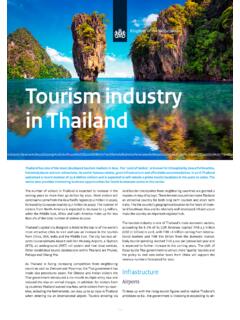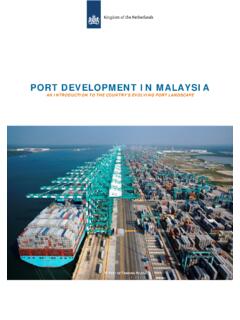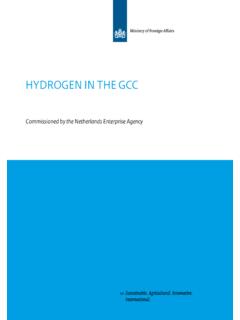Transcription of ARTIFICIAL INTELLIGENCE IN JAPAN 2020 - RVO
1 ARTIFICIAL INTELLIGENCE IN JAPAN 2020 Commissioned by the Netherlands Enterprise Agency P a g e 0 | 36 ARTIFICIAL INTELLIGENCE IN JAPAN 2020 ACTORS, MARKET, OPPORTUNITES AND DIGITAL SOLUTIONS IN A NEWLY TRANSFORMED Nicole Dirksen 5 October 2020 Co-author Sonoko Takahashi Embassy of the Kingdom of the Netherlands Innovation, Science and Technology a g e 1 | 36 CON T ENT S List of Figures .. 2 Summary .. 3 Introduction .. 4 AI Ecosystem .. 6 Public sector .. 7 Research Institutes .. 8 Private sector .. 9 The Japanese AI Market .. 14 AI on a global level .. 14 AI market in JAPAN .. 15 JAPAN s ambitions .. 17 Reinventing JAPAN through AI .. 19 Developments in JAPAN are favorable for AI .. 19 Political .. 19 Economic .. 20 Society .. 20 Technological .. 21 Legal .. 22 A window of opportunity for partnerships .. 23 Strenghts .. 24 Weaknesses .. 24 Opportunities .. 25 Challenges .. 25 AI post COVID-19 .. 26 COVID-19 as inhibitor of AI development.
2 26 Positive impact on AI developments .. 27 AI COVID-19 solutions .. 28 Conclusion .. 29 Bibliography .. 31 Cover picture form Go Tokyo P a g e 2 | 36 LIS T OF FIGU RES Figure 1: Actor analysis p. 6 Figure 2 Actor analysis governmental institutions p. 7 Figure 3: Electronics sector p. 10 Figure 4: Automotive sector p. 12 Figure 5: Robotics sector p. 13 Figure 6: Estimated global market value AI p. 14 Figure 7: Top ten Japanese companies for AI Patent families p. 15 Figure 8: Changes in the fields to which AI-related inventions are applied p. 16 Figure 9: Fusion of AI and other Related Technologies p. 18 Figure 10: Major inhibitors and drivers of the development of AI in JAPAN p. 19 Figure 11: SWOT analysis p. 24 P a g e 3 | 36 S U MMARY AI is booming, especially in JAPAN . This rapport will introduce the Japanese AI situation, the relevant actors, the market, its policy ambitions, its challenges and of course opportunities for the Netherlands.
3 Japans AI ecosystem exists of investments from the public and private sector combined, supporting a research environment in which AI can flourish. The Japanese government, coordinated by the Cabinet Office, is aided by the Council for Science, Technology and Innovation and the Strategic Council for AI Technology. The execution of their AI policies is divided over three ministries: Internal Affairs and Communication, Economy, Trade and Industry and Education, Culture, Sports, Science and Technology. Looking at the private sector, three big Japanese industries can be distinguished to be very active in AI-related developments: the automotive, robotics and electronics industries. Among these industries several different types of intersectoral and international relationships can be found. Of these three sectors, the automotive industry spends the most on R&D. The AI market can be concluded to be opportune.
4 The global AI market estimated compound annual growth rate between 2018 to 2025 differs from 33% to 55%. By 2025, the AI global market is projected to be worth between 156 and 360 billion euros. The Asia Pacific region is anticipated to overtake North America s number one spot on the global AI market by 2025. As to date, JAPAN has 200 to 300 AI-related companies. JAPAN is number one in the world as a supplier of industrial robots and third, after China and the USA, in AI R&D. On AI patens is Toshiba Japans highest contributor, claiming the world s third spot, right after IBM and Microsoft. JAPAN aims to stay a prominent player in the high-tech sector with AI as one of its vital components. JAPAN wants to utilize AI in its policies to address its own societal issues through its envisioned society of the future named Society As AI is named a core technology, it made its way into several policy proposals, like the Japanese Moonshot program, similar to Europe s Horizon2020, and the cross-ministerial Strategic Innovation Promotion Program.
5 SCAIT has developed a strategy especially for AI developments, consisting of three tracks. The first track is productivity, with a focus on the enhancement of creativity and innovative services. The second track is health, medical care and welfare coming from the urgent need to respond to its rapid aging society. Finally, the third track, mobility aims for everyone to be able to travel freely, safely and environmentally friendly. JAPAN faces several societal issues, some of which the Netherlands has shared experiences. A main problem for JAPAN is its rapid aging society, of which over 40% will be elderly in 2030. This puts pressure on the labor force and healthcare system. This pressure is also an incentive of AI enhanced care robots and industrial robots. Of course, as this rapport is written during the global COVID-19 pandemic, the world has and still is rapidly changing from starting this project to its finalization. Several new developments have spurred in the last months.
6 Related to AI, the pandemic seems to cause in some sector short-term budget cuts, but also sparked AI driven solutions and motivated faster digitalization of traditional physical activities in which AI plays a fundamental role. As to conclude, despite the pandemic, AI is still booming. JAPAN provides several opportunities for the Dutch private sector, for governmental institutions to exchange best policy practices and for researcher to broaden their expertise. P a g e 4 | 36 IN TRO DUC T IO N ARTIFICIAL INTELLIGENCE , or AI, is already entangled in our ordinary daily activities - like navigating, recommending news articles or setting your alarm clock automatically on workdays - and will play an important part in societies future design. The rapid technological developments and increased interests from national and international governmental institutions, research facilities and of course the private sector, created new opportunities as well as challenges, asking actors to respond and adapt.
7 JAPAN aims to design the society of the future, by developing a long-term strategy to adapt to the new opportunities that high-tech developments provide. Whereas it used to be common practice to collect information and let humans draw the conclusions from this data themselves, we are now evolving into a society were humans and systems are connected in a virtual space. AI is a key technology able to analyze huge amounts of data and translating it conveniently back to the human users. AI is therefore crucial in transforming the information society to the society of the future, also known in JAPAN as Society ; "A human-centered society that balances economic advancement with the resolution of social problems by a system that highly integrates cyberspace and physical space." (Cabinet Office, 2020). But what do we mean when we say ARTIFICIAL INTELLIGENCE ? Due to the multifunctionality of AI technology, the terminology for AI is often intertwined with other concepts.
8 The European Union defines AI as: Machines that are able to learn, reason, and act for themselves. 1 Within this context, this report focuses on the current situation and therefore on ARTIFICIAL Narrow INTELLIGENCE (ANI). This refers to AI systems which are able to perform specific tasks autonomously, but can only operate within the range of the jobs the technology is programed to do. Even the most complicated AI technology created to date is still ANI, also known as reactive or limited memory machines. ANI also includes AI that makes use of machine learning or deep learning to improve their own performances, like virtual assistants or self-driving cars. ANI is not AI that can function completely like a human being ( ARTIFICIAL General INTELLIGENCE ) or that possesses self-awareness ( ARTIFICIAL Superintelligence), of which the first is currently still a work in progress and the later a hypothetical concept not likely to be realized in the coming decades (Forbes, 2019).
9 The majority of AI is currently making use of machine learning, based on statistical patterns gathered from large data sets. AI can learn from this data to make predictions and create useful insights (Global Orange, 2020). This ever-increasing amount of data gathered through our devices, sensors and online activities are collected in a virtual space, also known as cyberspace. The data is analyzed by AI and the results are fed back to us in our physical space as well. Examples are the introduction of the self-driving car able to avoid traffic jams or the virtual assistant which can make personalized recommendations. With this AI technology, Society aims to meet the specific needs of each individual. The 6th Science and Technology Basic Plan for 2021-2026, a Japanese five-year policy plan directing towards a Society (Kuczynska, 2019), will be published this year. Therefore, this year will also mark the end of the Japanese 5th Science and Technology Basic Plan (CSTI, 2015).
10 Looking back at the developments 1 As used by the European Union (European Union, 2019). P a g e 5 | 36 during the 5th plan and the set of goals for the future, provides insights in possible opportunities and perhaps a closer Japanese-Dutch relationship in the AI field. To provide insights and prepare Dutch actors interested in the Japanese AI developments, this report will highlight the relevant Japanese actors, market and political and economic context. By presenting what the expected developments as well as barriers are, this report provides keynotes for whoever is interested in exploring the prospect of the Japanese AI ambition. To help those who are newly interested to understand the wide variety of AI-related practices, included below is a quick overview of the most prominent techniques and applications of AI technologies in JAPAN and examples of AI applications daily used by the average consumer.










